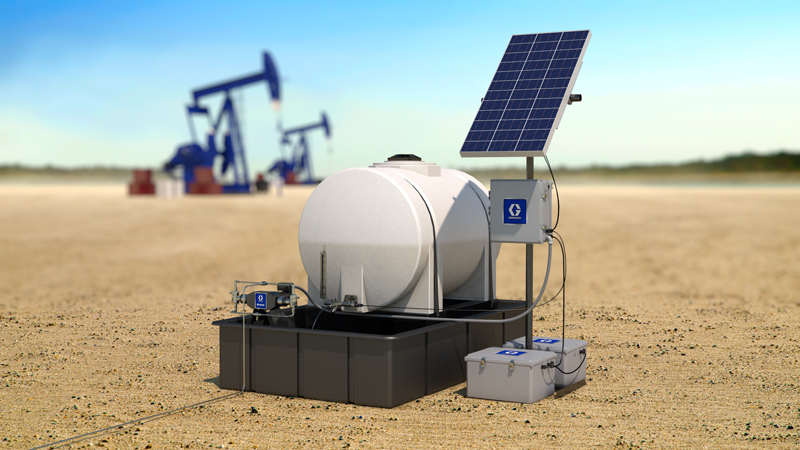 Corrosion can be one of the primary causes of problems in oil and natural gas pipelines. As oil and gas pipeline materials react with highly corrosive media (H2S, CO2 and water), the structural integrity of the pipeline can be degraded, potentially leading to leaks, fractures, and potentially catastrophic failures. To combat corrosion, many pipeline owners/operators utilize chemical injection methodologies, where a precisely controlled amount of corrosion inhibitor is injected into the pipeline or well site.
Corrosion can be one of the primary causes of problems in oil and natural gas pipelines. As oil and gas pipeline materials react with highly corrosive media (H2S, CO2 and water), the structural integrity of the pipeline can be degraded, potentially leading to leaks, fractures, and potentially catastrophic failures. To combat corrosion, many pipeline owners/operators utilize chemical injection methodologies, where a precisely controlled amount of corrosion inhibitor is injected into the pipeline or well site.
Corrosion Causes
Carbon steel is commonly used in oil and gas pipelines due to its strength, toughness, and ability to withstand temperature changes.
Steel, however, is subject to corrosion triggered by the presence of water, carbon dioxide, hydrogen sulfide, and other elements present in soil, air, and the product being carried in the pipeline. Carbon dioxide (CO2), for example, is an acidic compound often present in natural gas and crude oil. It becomes particularly corrosive when dissolved in water, leading to pitting and other types of corrosion. Hydrogen sulfide (H2S) is formed from decomposing organic matter and produces an offensive “rotten egg” odor. It occurs naturally in some groundwater and is often found in wells drilled in shale or sandstone, or near petroleum deposits. When combined with water, it forms sulfuric acid (H2SO4), a strongly corrosive acid.
The presence of corrosive elements can be influenced by temperature, flow velocity, and surface condition of the steel. For example, temperature reductions can result in condensation of water and hydrocarbons, producing higher levels of CO2 and H2S and a more corrosive environment. Higher velocities can lead to increased turbulence and accelerated corrosion. Steel that is scored or damaged presents more opportunities for corrosion to attack weakened areas of pipelines.
Inhibiting Corrosion with Technology
A variety of techniques have been used to limit corrosion, such as coatings and cathodic protection. Coatings can be applied to both the interior and exterior of pipelines to ward off corrosion. When applied to pipeline interiors, coatings can also produce smoother surfaces, reducing friction and enhancing flow efficiency. Coatings, however, become less effective as the coating is worn away.
Cathodic protection is the application of electrical current to the pipeline to disrupt the movement of electrons and protect the steel from corrosion. Its use and effectiveness often depends on the nature of the pipeline system and the geological characteristics of the area under consideration.
Chemical injection can offer a dependable, measurable way to ward off corrosion. Corrosion inhibitors can be injected into the pipeline or well site in specific concentrations to reduce corrosion. They do so by forming a protective film on the metallic surface and slowing the corrosive reactions.
Chemical Pumps Inject Corrosion Inhibitors
Using modern technology, chemicals can be injected and monitored precisely, often with remote equipment that does not require staff to be on-site. Chemicals are dispensed with pumps designed to fit various pressure and flow requirements. Electric pumps are commonly used, operating off either AC or DC power. Solar DC power can be used in remote areas.
Pneumatic pumps can run off natural gas or compressed air. They can be used in applications that require hazardous location equipment and/or do not have accessibility to AC grid power.
Accurate chemical dosing is critical to successful corrosion inhibition. Under-dosing can limit the effectiveness of corrosion prevention, while over-dosing can lead to waste and excess costs. When sizing pumps, it’s important to know what the volume and pressure output of the pumps should be as well as the chemical compatibility requirements of the seals.
Electric pumps can be powered by solar or conventional power sources.
|
Pneumatic pumps run off regulated natural gas or compressed air.
|
Controllers Provide Brains
Controllers serve as the “brains” of chemical injection systems, and can be selected based on power requirements, levels of automation desired, and other factors. They can provide a simple time-based control for chemical injection, cycle control or an adaptive flow control process which improves accuracy and provides flow assurance. Remote system monitoring and control is also available, with automation features including: tank level monitoring, pressure, flow & temperature measurement and leak detection.
Complete Chemical Injection System solutions
To complete the chemical injection system, other components could include a solar panel, stand, batteries, and charge controller if solar power is used. Other components could also include chemical storage tanks, piping, fittings, calibration column and various other accessories to complete the system.
Dynapumps are an authorised Graco dealer with an expert team that can help you with chemical injection pump solutions, extensive product knowledge and installation/service. Contact Dynapumps today on 1300 788 579 or email sales@dynapumps.com.au.